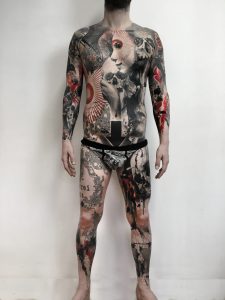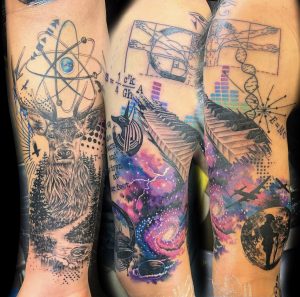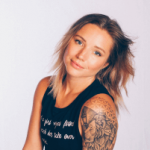Tattoo Glossary T to Y
T
Tattoo Machine — the proper name for that which most artists today use to apply the ink to a person’s skin. The first version uses rotary technology, with an electric motor to drive the needles. Its succesor, the coil machine is considered the standard for modern tattooing. An electromagnetic circuit moves the needles, and the coils create resistance. It gives the artist more control, whereas a rotary machine is lighter and less noisy as it doesn’t vibrate.
Tebori — a technique used in traditional Japanese tattooing. It literally translates into “carving by hand.” The artist uses a nomi, a wooden or metal stick with needles attached to it, to insert the ink into the skin. This method dates all the way back to the Edo period beginning in the 17th century, but is still used by Japanese artists today. Out of all the styles, this is one of the toughest to learn from a master, as the student reportedly must take on a five-year apprenticeship, which includes learning all the stories behind the symbols of the tradition.

Tramp Stamp — a slang for tattoos located on someone’s, usually a female individual’s, lower back. They became popular in the late 1990s and early 2000s along with the low-rise jeans. The placement has faded significantly in popularity due to the connotations of the derogatory term.
Trash Polka — a tattoo style created by two artists from Germany, Simone Pfaff and Volker Merschky in their Buena Vista Tattoo Club. Or, at the very least, they came up with the name for it and subsequently trademarked it in 1998. It is done mainly in black and red and features a combination of naturalistic and surrealistic motives, calligraphic elements and abstract and geometric styles.
Tribal — usually associated with the spiky, black shapes moving up and down shoulders and necks during the 90s, but really any traditional tattoos that were used to mark belonging to a certain group or culture. The word literally means “of a tribe.”
W

Watercolour — a relatively new, increasingly sought-after style that, just as the name implies, imitates the brushstrokes and the colour palette of watercolour paintings. The colours are usually soft and gradient, and spill over and across thinner black outlines.
Y
Yakuza — a sub-style to the Irezumi tradition. The Yakuza first got tattooed as a way to cover up their branding as criminals, but later specific sets of symbols and compositions evolved to signal belonging to a particular group within the crime syndicate. It is still considered a rite of initiation, and often done in a body suit. However, any skin that is visible when fully clothed is left untouched, along with a broad strip of skin from the neck down to the pelvis so that they would remain invisible under a kimono.
Yantra/Sak Yant Tattoos — a hand-poked technique that originated in the Khmer Empire in Cambodia and then spread over Southeast Asia. Traditionally performed by monk masters, they are done with a sharpened bamboo stick. They have a specific set of patterns and symbols that are believed to be a kind of magical incantations, bestowing mystical powers and protection.
